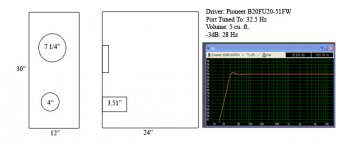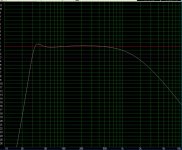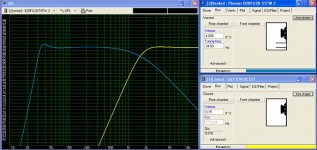Hello,
In order to get a better feel for speaker design, I've been playing around with WinISD for the last few weeks and I stumbled onto a simulated design that looks promising.
It is a large (5 cu. ft.) bass reflex enclosure based on a single Pioneer B20FU20-51W. It is tuned to 32.5 Hz and, assuming I have WinISD setup right, is fairly flat down to 50 Hz. While this started out as a theoretical exercise, I'm seriously thinking about building them as an upgrade for my office system. (Either that, or a pair of Buschhorns)
Anyway, I'd love any comments that people have on this design. I'm more or less a total newbie to enclosure design, so any ideas or advice would be GREATLY appreciated.
Thanks in advance.
In order to get a better feel for speaker design, I've been playing around with WinISD for the last few weeks and I stumbled onto a simulated design that looks promising.
It is a large (5 cu. ft.) bass reflex enclosure based on a single Pioneer B20FU20-51W. It is tuned to 32.5 Hz and, assuming I have WinISD setup right, is fairly flat down to 50 Hz. While this started out as a theoretical exercise, I'm seriously thinking about building them as an upgrade for my office system. (Either that, or a pair of Buschhorns)
Anyway, I'd love any comments that people have on this design. I'm more or less a total newbie to enclosure design, so any ideas or advice would be GREATLY appreciated.
Thanks in advance.
Attachments
blip1882 ,
When I model this driver in WinISD I get different plots. In winISD, after you select your driver and your box type it comes up with the box that has the flattest frequency responce. When I use the T/S parameters from here the flattest frequency responce is a 2.868^3ft box tuned to 34.87hz.
When you make the box so much larger you get the low end hump and the you begin to sag. If you wanted it flat at 50hz than I would use the winISD recomended tuning frequency and size, but if you wanted more bass than you have got the right design. Below is a plot that I made on WinISD to show you the differences.
What are you going to do about helping the with the highs?
Josh
When I model this driver in WinISD I get different plots. In winISD, after you select your driver and your box type it comes up with the box that has the flattest frequency responce. When I use the T/S parameters from here the flattest frequency responce is a 2.868^3ft box tuned to 34.87hz.
When you make the box so much larger you get the low end hump and the you begin to sag. If you wanted it flat at 50hz than I would use the winISD recomended tuning frequency and size, but if you wanted more bass than you have got the right design. Below is a plot that I made on WinISD to show you the differences.
What are you going to do about helping the with the highs?
Josh
An externally hosted image should be here but it was not working when we last tested it.
It's the right way to get more bass, but be carefull : I built an enclosure like that, with a slight dip between the lowest frequency and ~ 100Hz, and in fact I got a huge dip between the low hump and 100Hz ! It may work like it couldn't, due to eventul baffle step issues.
Maybe you could make a compromise IMO ?
For example keep the box volume and tune it higher : you will get a bigger hump that can be easily damped, and a smaller dip !
Maybe you could make a compromise IMO ?
For example keep the box volume and tune it higher : you will get a bigger hump that can be easily damped, and a smaller dip !
Thanks so much for doing the modeling!
I checked the T/S parameters you used against the ones from Parts Express that I had used and there are a couple of differences... I assume the ones from Single Driver are more reliable? Anyway, I'll remodel it after work today.
I had wanted to design the box to go as low as possible but I certainly want to avoid a boomy or unbalanced sound. Subjectively, how much of a hump and dip do you think is acceptable without seriously imparing sound quality? Also, from my playing with WinISD it seems like I can remove a lot of the hump with stuffing... any idea how that might effect the sound in this design?
Thanks again.
I checked the T/S parameters you used against the ones from Parts Express that I had used and there are a couple of differences... I assume the ones from Single Driver are more reliable? Anyway, I'll remodel it after work today.
I had wanted to design the box to go as low as possible but I certainly want to avoid a boomy or unbalanced sound. Subjectively, how much of a hump and dip do you think is acceptable without seriously imparing sound quality? Also, from my playing with WinISD it seems like I can remove a lot of the hump with stuffing... any idea how that might effect the sound in this design?
Thanks again.
IMHO, a dip is never acceptable. Baffle losses decrease the bass enough like this.
A hump can be interesting because it can be damped, or reinforce a null in your room.
I also noticed that a hump could be redistributed at lower frequencies if the speaker was placed in a wall corner.
Look at my TB designs on my website, there are measurements.
Greets !
A hump can be interesting because it can be damped, or reinforce a null in your room.
I also noticed that a hump could be redistributed at lower frequencies if the speaker was placed in a wall corner.
Look at my TB designs on my website, there are measurements.
Greets !
First of all thanks so much for the replies, I'm quite enjoying learning about speaker design.
Finally found time to remodel this with the new specs. Wow they make a big difference! After playing around with it a little I think the best option would be a 4 cu ft. box tuned to 33.5. It isn't as flat as the recommended but it goes considerably deeper and the dip is less than -.2 dB under flat. Anyway, I attached the graph
As for high frequency assistance, I was thinking about eventually adding a tweeter "pod" on top of the speaker. Given the poor high frequency performance of this driver on the new graph (-3 dB at 1800 Hz) I'm starting to think a tweeter is a necessity, not a luxury with this driver... So back to the drawing board as far as high-frequency stuff goes... any advice on a tweeter that might mate well?
Also, the poor high-frequency performance of this driver is leading me to wonder if I should find something with a better high range and eventually add a sub-woofer to the setup. Any thoughts on this?
Thanks again.
Finally found time to remodel this with the new specs. Wow they make a big difference! After playing around with it a little I think the best option would be a 4 cu ft. box tuned to 33.5. It isn't as flat as the recommended but it goes considerably deeper and the dip is less than -.2 dB under flat. Anyway, I attached the graph
As for high frequency assistance, I was thinking about eventually adding a tweeter "pod" on top of the speaker. Given the poor high frequency performance of this driver on the new graph (-3 dB at 1800 Hz) I'm starting to think a tweeter is a necessity, not a luxury with this driver... So back to the drawing board as far as high-frequency stuff goes... any advice on a tweeter that might mate well?
Also, the poor high-frequency performance of this driver is leading me to wonder if I should find something with a better high range and eventually add a sub-woofer to the setup. Any thoughts on this?
Thanks again.
Attachments
The more I've thought about it, the more I think you are right, youyoung. Allowing the dip is too much of a compromise for a little more extension. Besides that, I can always cancel the hump with absorption, but the dip will be there to stay not matter what I do! (Speaking of this, in this design, what would be the best way to include absortive material?)
Anyway, the best compromise seems to be 4 cu ft. at 34.5.... This is basically what WinISD recommended but in a little larger box to push the bass lower. The hump is around +1 dB @ 39.5 Hz.
In terms of trebel, I was playing around with this Daytin DC25T-8 in WinISD last night. It seems to go low enough to cross-over nicely with the Pioneer. (see below for a response graph of both without any crossover) Any comments on it? I've just started my search for tweeters so any other (reasonably priced) alternatives would be highly appreciated.
As for placement, I had planned on leaving the tweeter somewhat optional by placing it in a seperate (very small) enclosure. This will allow me to tweak the efficiency of the tweeter to match the efficiency of the Pioneer. Is this a good approach? Or should I just integrate the tweeter into the main cabinet?
Anyway, the best compromise seems to be 4 cu ft. at 34.5.... This is basically what WinISD recommended but in a little larger box to push the bass lower. The hump is around +1 dB @ 39.5 Hz.
In terms of trebel, I was playing around with this Daytin DC25T-8 in WinISD last night. It seems to go low enough to cross-over nicely with the Pioneer. (see below for a response graph of both without any crossover) Any comments on it? I've just started my search for tweeters so any other (reasonably priced) alternatives would be highly appreciated.
As for placement, I had planned on leaving the tweeter somewhat optional by placing it in a seperate (very small) enclosure. This will allow me to tweak the efficiency of the tweeter to match the efficiency of the Pioneer. Is this a good approach? Or should I just integrate the tweeter into the main cabinet?
Attachments
blip1882,
yes, high frequency help is definately needed! You can use whatever you want to do that. For a while I used a w3-871 for high frequency help. Its up to you whether you think you would rather have the tweeter in another box or not. You can always build the box for the b20fu and have the tweeter in another box until you figure out your crossover and then cut the holes in the b20fu box to add the tweeter. Personally I like them in a box together, but I'm not going be the person looking at it everyday, so just pick out what you think would look best.
The dayton seems fine, I'm not a big fan of metal tweeters but if you like them than go for it. Since these are going to be in your office you will be listening to them for long periods so you want a tweeter that won't hurt or wear you out after hours of listening.
By the way, I added duct seal to the b20fus and it made a big difference.
Josh
yes, high frequency help is definately needed! You can use whatever you want to do that. For a while I used a w3-871 for high frequency help. Its up to you whether you think you would rather have the tweeter in another box or not. You can always build the box for the b20fu and have the tweeter in another box until you figure out your crossover and then cut the holes in the b20fu box to add the tweeter. Personally I like them in a box together, but I'm not going be the person looking at it everyday, so just pick out what you think would look best.
The dayton seems fine, I'm not a big fan of metal tweeters but if you like them than go for it. Since these are going to be in your office you will be listening to them for long periods so you want a tweeter that won't hurt or wear you out after hours of listening.
By the way, I added duct seal to the b20fus and it made a big difference.
Josh
I don't know particular tweeters, but at first, I wouldn't integrate anything in the cabinet until you adjusted phase . This is a very important part that affects the coherence of both speakers. A wave that is reproduced by the two drivers must be synchronized unless you'll alter the sound very very much. The best way to adjust phase is, as you suggest it, to build a small box placed on the top of the enclosure.
Maybe you could use a Fostex FF85K for HF reinforcement : it has a nice frequency response in the highs !
Concerning damping, use some health-safe materials, like polyester wool.
I've just changed the port (put on the side and shorter) on my "too low tuned" enclosure : I get a flatter response, but more than this, I get a much tighter bass ! Almost as good as a sealed enclosure ! I'm quite astonihed by this. Music is more "fast" and "alive".
You can always adjust tuning according to your tastes later.
Maybe you could use a Fostex FF85K for HF reinforcement : it has a nice frequency response in the highs !
Concerning damping, use some health-safe materials, like polyester wool.
I've just changed the port (put on the side and shorter) on my "too low tuned" enclosure : I get a flatter response, but more than this, I get a much tighter bass ! Almost as good as a sealed enclosure ! I'm quite astonihed by this. Music is more "fast" and "alive".
You can always adjust tuning according to your tastes later.
edjosh23 said:youyoung21147,
I find it ironic we are both trying to help, considering we are the youngest on the website.
Josh
LOL
But experience may not be proportionnal to age !
Though I don't have much experience with ported boxes, I try to share my more or less happy trials.
I'm really in a hurry to get my new TQWTs for my FX120, BTW

- Status
- This old topic is closed. If you want to reopen this topic, contact a moderator using the "Report Post" button.
- Home
- Loudspeakers
- Full Range
- Need Comments on FR Bass Reflex


